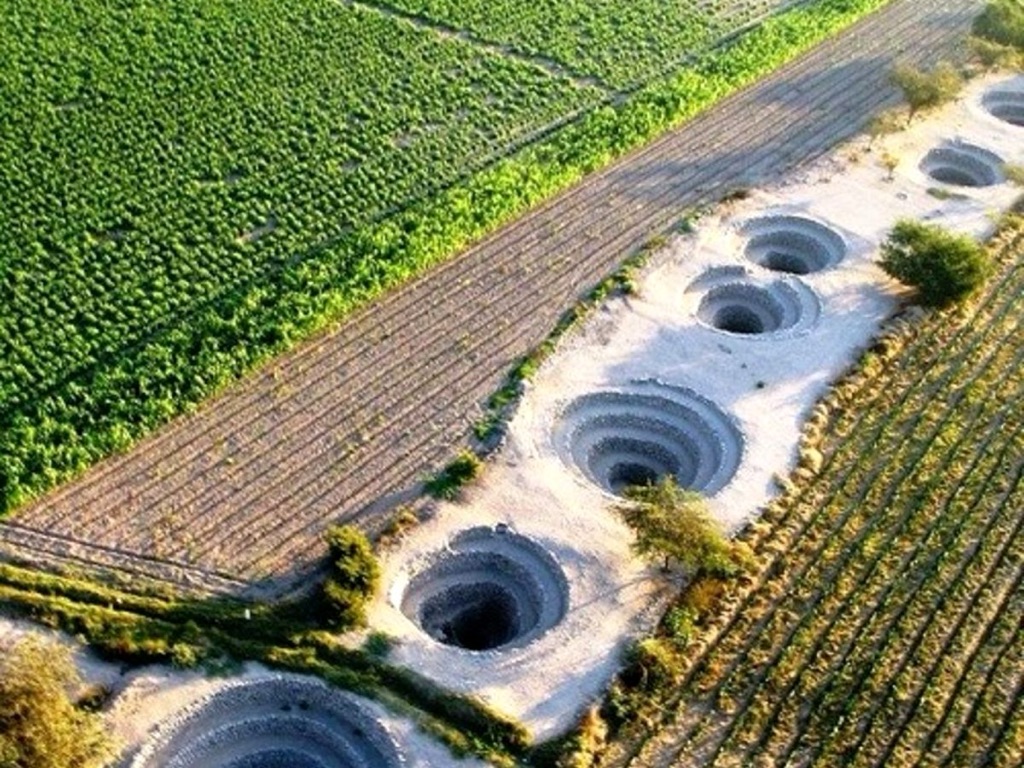The Cantalloc Aqueducts are an ancient marvel of engineering located near the city of Nazca in Peru. These subterranean aqueducts, also known as ‘puquios’, are a sophisticated system designed for water management in an arid environment. They date back to the Nazca culture, which flourished between 200 BCE and 600 CE. The aqueducts are a testament to the ingenuity of the Nazca people, showcasing their understanding of their environment and their ability to adapt to it.
Get your dose of History via Email
Historical Background of Cantalloc Aqueducts
The Cantalloc Aqueducts were discovered in the 1920s by Peruvian archaeologist Toribio Mejia Xesspe. He stumbled upon them while studying ancient Nazca lines. The aqueducts were built by the Nazca culture, known for their geoglyphs and pottery. The region’s inhabitants later maintained the aqueducts, which continued to be used into the colonial period and beyond. The site has not been the scene of any known historical events but remains a significant cultural heritage site.
The Nazca people created the Cantalloc Aqueducts to respond to the harsh desert conditions. They needed a reliable water source for agriculture and survival. The aqueducts allowed them to harness groundwater and ensure a year-round supply. This innovation was crucial for the development of the Nazca civilization, enabling them to thrive in an otherwise inhospitable landscape.
Over time, the aqueducts have seen various inhabitants and uses. After the decline of the Nazca culture, other groups, such as the Wari and Inca, may have used and maintained the aqueducts. Their continued use into the modern era highlights their importance and effectiveness. The aqueducts are a symbol of continuity and resilience in the face of environmental challenges.
The Cantalloc Aqueducts have not been the site of any major historical battles or events. However, they are historically important for their role in the survival and development of the Nazca culture. They are a physical representation of the advanced understanding of hydraulics and civil engineering that existed in pre-Columbian South America.
Today, the Cantalloc Aqueducts are recognized as an important archaeological site. They attract researchers and tourists alike, who come to marvel at the ingenuity of the ancient Nazca people. The site is a reminder of the sophisticated technologies developed by ancient civilizations, long before the advent of modern engineering.
About Cantalloc Aqueducts
The Cantalloc Aqueducts are a network of underground channels and above-ground spiral openings known as ojos. They were constructed using a combination of stone, gravel, and huarango wood, which is resistant to decay. The aqueducts are an example of the Nazca’s advanced knowledge of geology and hydrology.
The construction of the aqueducts involved digging narrow underground tunnels to tap into the subterranean water. The spiral openings served as access points for maintenance and helped to aerate the water. The design also helped to filter out sediment, ensuring a clean water supply.
The architectural highlights of the Cantalloc Aqueducts include their resilience and sustainability. The system has survived for over a thousand years, with some parts still functioning today. The aqueducts’ design demonstrates the Nazca’s ability to work with their environment, rather than against it.
The building materials were sourced locally, demonstrating the Nazca’s resourcefulness. The use of huarango wood, in particular, is notable for its durability and resistance to the elements. This choice of material contributed to the longevity of the aqueducts.
The Cantalloc Aqueducts are not only an engineering feat but also an artistic one. The spiral openings create a striking visual pattern on the landscape, reminiscent of the famous Nazca lines. The combination of functionality and aesthetics is a hallmark of Nazca culture.
Theories and Interpretations
Several theories exist about the purpose and construction of the Cantalloc Aqueducts. The most widely accepted theory is that they were built for water management and irrigation. This is supported by the arid climate of the region and the agricultural needs of the Nazca people.
Some mysteries surround the aqueducts, such as the precise methods used to construct them. The Nazca left no written records, so researchers must rely on archaeological evidence. Theories suggest that the Nazca may have used trial and error, along with their observations of the environment, to develop the aqueducts.
The aqueducts have been matched to historical records through carbon dating and other archaeological methods. These techniques have helped to confirm the age of the structures and their association with the Nazca culture.
There is also speculation about the role of the aqueducts in Nazca society. Some scholars suggest that they may have had a ceremonial or religious significance, in addition to their practical use. The exact nature of this significance remains a topic of research and debate.
The dating of the Cantalloc Aqueducts has been carried out using radiocarbon dating and stratigraphy. These methods have helped to establish a timeline for the construction and use of the aqueducts, providing insight into the history of the Nazca culture.
At a glance
Country: Peru
Civilization: Nazca Culture
Age: Approximately 200 BCE to 600 CE
Conclusion and Sources
Reputable sources used in the creation of this article include:
- Wikipedia: https://en.wikipedia.org/wiki/Puquios
- World History Encyclopedia: https://www.worldhistory.org/Nazca_Civilization/

